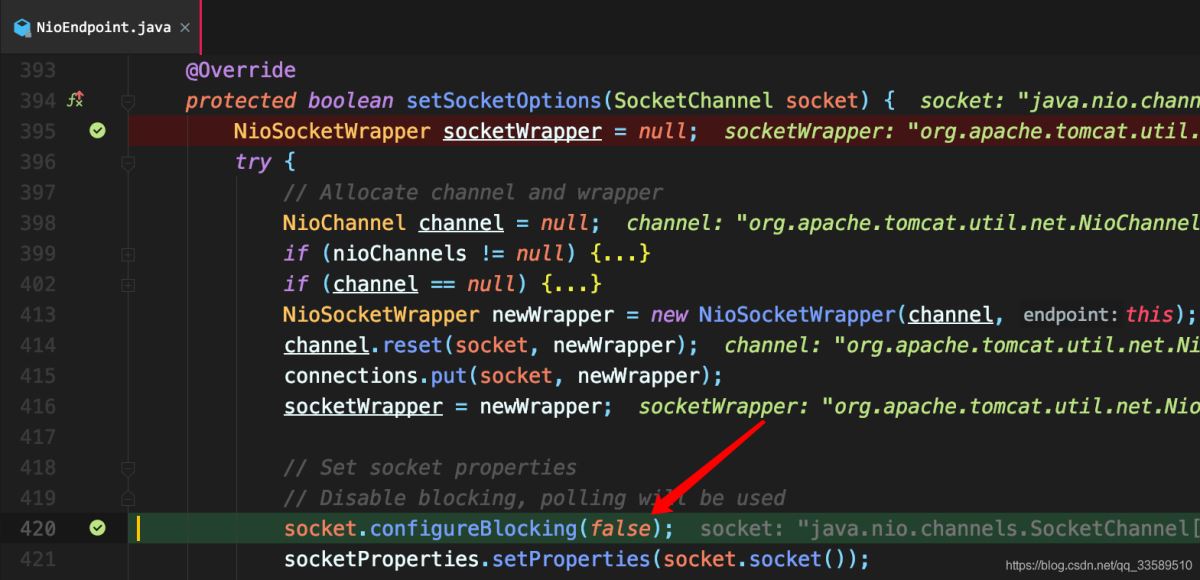Connector啟動過程
Connector是Tomcat提供的類。
// 通過此 Connector 開始處理請求
@Override
protected void startInternal() throws LifecycleException {
// Validate settings before starting
if (getPortWithOffset() < 0) {
throw new LifecycleException(sm.getString(
"coyoteConnector.invalidPort", Integer.valueOf(getPortWithOffset())));
}
setState(LifecycleState.STARTING);
try {
// 核心動作
protocolHandler.start();
} catch (Exception e) {
throw new LifecycleException(
sm.getString("coyoteConnector.protocolHandlerStartFailed"), e);
}
}
springboot默認會在8080端口提供 HTTP 服務,所以這里是一個處理HTTP協議請求的 Http11NioProtocol 實例,使用 NIO 方式處理 HTTP 協議。
Connector 對HTTP請求的接收和處理并非親自完成,而是委托該 Http11NioProtocol protocolHandler 完成

而 protocolHandler 又進一步將請求處理工作交給 NioEndpoint 完成。
AbstractProtocol
@Override
public void start() throws Exception {
if (getLog().isInfoEnabled()) {
getLog().info(sm.getString("abstractProtocolHandler.start", getName()));
logPortOffset();
}
endpoint.start();
monitorFuture = getUtilityExecutor().scheduleWithFixedDelay(
new Runnable() {
@Override
public void run() {
if (!isPaused()) {
startAsyncTimeout();
}
}
}, 0, 60, TimeUnit.SECONDS);
}
調用鏈 :
- Connector.start()
- startInternal()
- Http11NioProtocol protocolHandler.start();
- Http11NioProtocol 的 start方法,由基類 AbstractProtocol 提供實現。它們都是tomcat提供的類。
- NioEndpoint endpoint.start()
start成員變量endpoint,一個 NioEndpoint 實例。Http11NioProtocol 類實例也并非最終處理請求,具體這些請求的處理都委托給了 NioEndpint endpoint 來完成

AbstractEndpoint
throws Exception {
if (bindState == BindState.UNBOUND) {
bindWithCleanup();
bindState = BindState.BOUND_ON_START;
}
startInternal();
}
可見 tomcat 的三種模式,默認使用 NIO 模式。

@Override
public void bind() throws Exception {
initServerSocket();
setStopLatch(new CountDownLatch(1));
// Initialize SSL if needed
initialiseSsl();
selectorPool.open(getName());
}
throws Exception {
if (!getUseInheritedChannel()) {
// 建立服務套接字
serverSock = ServerSocketChannel.open();
socketProperties.setProperties(serverSock.socket());
InetSocketAddress addr = new InetSocketAddress(getAddress(), getPortWithOffset());
// 綁定到指定端口
serverSock.socket().bind(addr,getAcceptCount());
} else {
// Retrieve the channel provided by the OS
Channel ic = System.inheritedChannel();
if (ic instanceof ServerSocketChannel) {
serverSock = (ServerSocketChannel) ic;
}
if (serverSock == null) {
throw new IllegalArgumentException(sm.getString("endpoint.init.bind.inherited"));
}
}
// 設置 serverSock 為阻塞模式
serverSock.configureBlocking(true); //mimic APR behavior
}
serverSocket配置的是阻塞模式,明明默認使用NIO 模式,為何還要設置阻塞模式呢?
為什么使用NIO,因為BIO的accept是阻塞方法,write和read也都是阻塞的。只能當新連接到來時,去創建新線程去處理這個連接。如此,最大問題是不能同時處理大量連接,因為大量連接帶來的是創建很多線程,大量線程很容易讓操作系統崩潰,而且雖然并發度很高,但是很多線程都在空轉,很多時間都浪費在線程空跑和線程切換上,效率也很差。
于是誕生了NIO。
其實處理連接的操作不必放在后臺線程,因為后臺線程很可能會處理連接建立不及時,不如將其置于主線程,增加并發度(雖然優勢并不是特別明顯)。
重點關心的是連接建立后獲得的與客戶端交互的那個socket,它的操作必須是非阻塞的,這很顯然。因為在處理長連接時,我們關心的是在本次連接之內數據的讀寫。
NioEndpoint 正在使用阻塞模式的 ServerSocketChannel 以使其阻塞并等待連接傳入,并且只有在accept后,才以非阻塞方式處理此傳入的socket channel (見setSocketOptions 方法)。
正如作者指出的那樣,使 ServerSocketChannel 成為非阻塞的將導致忙讀取,即一個線程將不斷輪詢有無傳入的連接,因為在非阻塞模式下 accept() 可能返回 null。
APR 代表 Apache Portable Runtime
Tomcat在接收到socket的時候做了如下操作:



參考
https://blog.csdn.net/andy_zhang2007/article/details/78641974
https://stackoverflow.com/questions/23168910/why-tomcats-non-blocking-connector-is-using-a-blocking-socket
到此這篇關于SpringBoot應用啟動內置Tomcat的過程分析的文章就介紹到這了,更多相關SpringBoot 內置Tomcat啟動內容請搜索服務器之家以前的文章或繼續瀏覽下面的相關文章希望大家以后多多支持服務器之家!
原文鏈接:https://blog.csdn.net/qq_33589510/article/details/118731992













